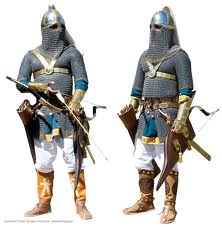
Siege of Maogamalcha(Maiozamalcha) |
year: 36310-13 May 363 |
| The Romans captured and destroyed the city of Maogamalcha | ★ ★ ★ ★ ★ |
|
enemy: Sassanid Persians
|
location: On the Tigris-Euphrates canal, 90 stadia (16km) from ancient Ctesiphon
|
accuracy:
●●●●●
|
|
battle type: City Capture |
war: Later Roman-Persian Wars |
modern country:
Iraq |
| ▼ The Byzantines(emperor: Julian the Apostate) | ▼ The Enemies | |
| Commander: | Emperor Julian | Unknown |
| Forces: | 65,000 | Unknown |
| Losses: |
| Background story: |
| In response to earlier attacks on Roman Mesopotamia by Shapur II of Sassanid Persia, Emperor Julian decided to deal with the Persian threat. On 5 March 363, despite a series of omens against the campaign, Julian departed from Antioch with a large army of 80,000–95,000 men. Emperor Julian adter sending a detachment of 30,000 to Armenia, advanced down the Euphrates, where he razed Pirisabora, then moved along the strategic canal to the Tigris against the powerful fortress city of Maogamalcha, the last major defense before the capital. |
The Battle: |
 Sassanid warriors Julian’s campaign was accompanied from the beginning by a unit of catapults and other siege engines that had crossed all of Syria with him. Julian used them against the walls of Maozamalha, but to no avail. The frontal attacks also proved futile. When all other failed, Julian’s engineers dug a tunnel beneath the walls, through which 1,500 men were able to crawl through and suddenly found themselves in the city, behind the enemy’s defensive positions. From there, capturing the city was easy. The Romans showed no mercy to the inhabitants, who in the previous days, feeling safe behind their “invincible” walls, had offended the soldiers of Julian and the apostate of the Persian court, Hormisdas. The city was looted and destroyed, including the palaces and gardens of the Persian monarch. |
Noteworthy: |
| The ancient Romans had the principle murum aries attigit (meaning “aries touched the wall”) according to which they showed no mercy when they conquered a city that did not surrender before their siege ram touched the wall. So they always destroyed the cities that resisted them and made it difficult for them, and the same happened in Maozomachla, apart from the insults and mockery of the defenders. |
Aftermath: |
| Then Julian’s army moved to the capital, Ctesiphon, which now looked like easy prey. As the army moved towards the Persian capital, the enemy broke the dams of the rivers, turning a huge area into a swamp. The movement of the army became painful and desperately slow. Julian won again, but when he reached Ctesiphon the army was exhausted and without supplies, so he failed to capture it. |
|
|
